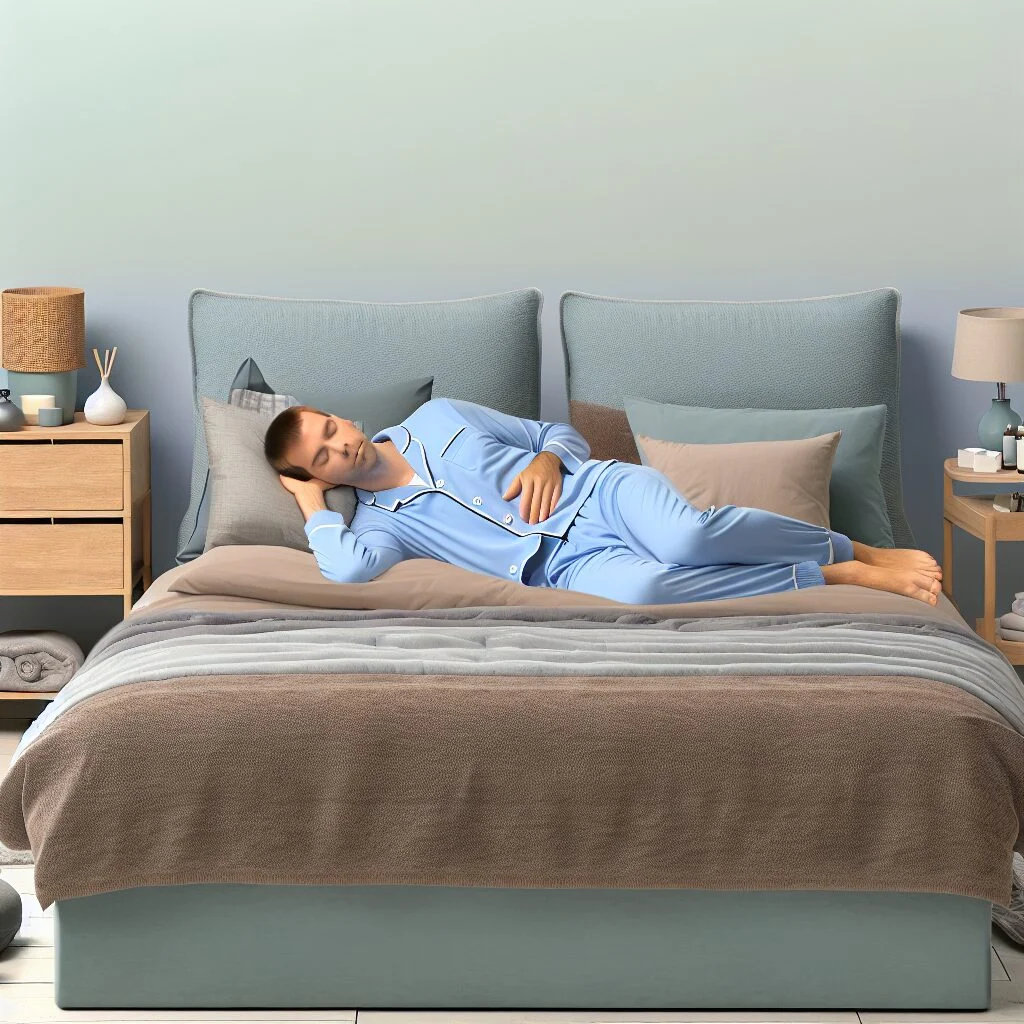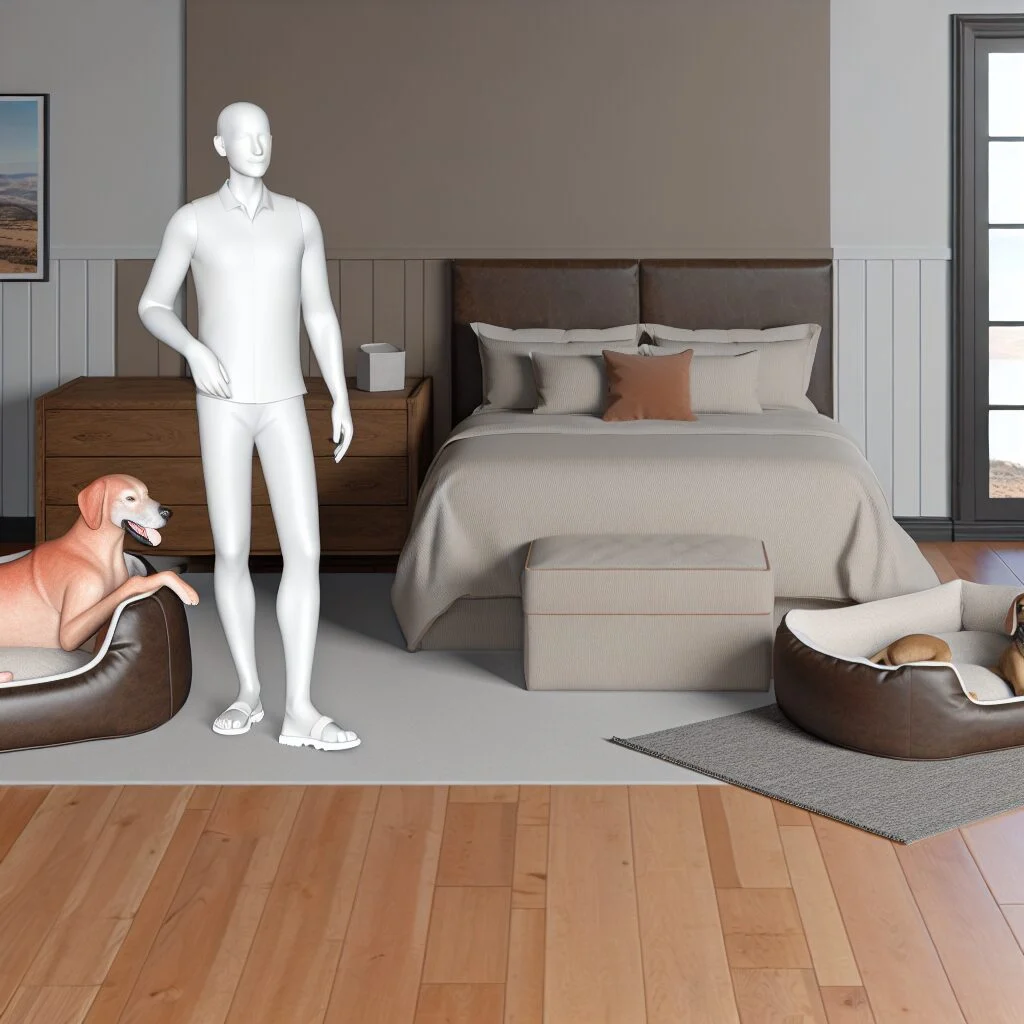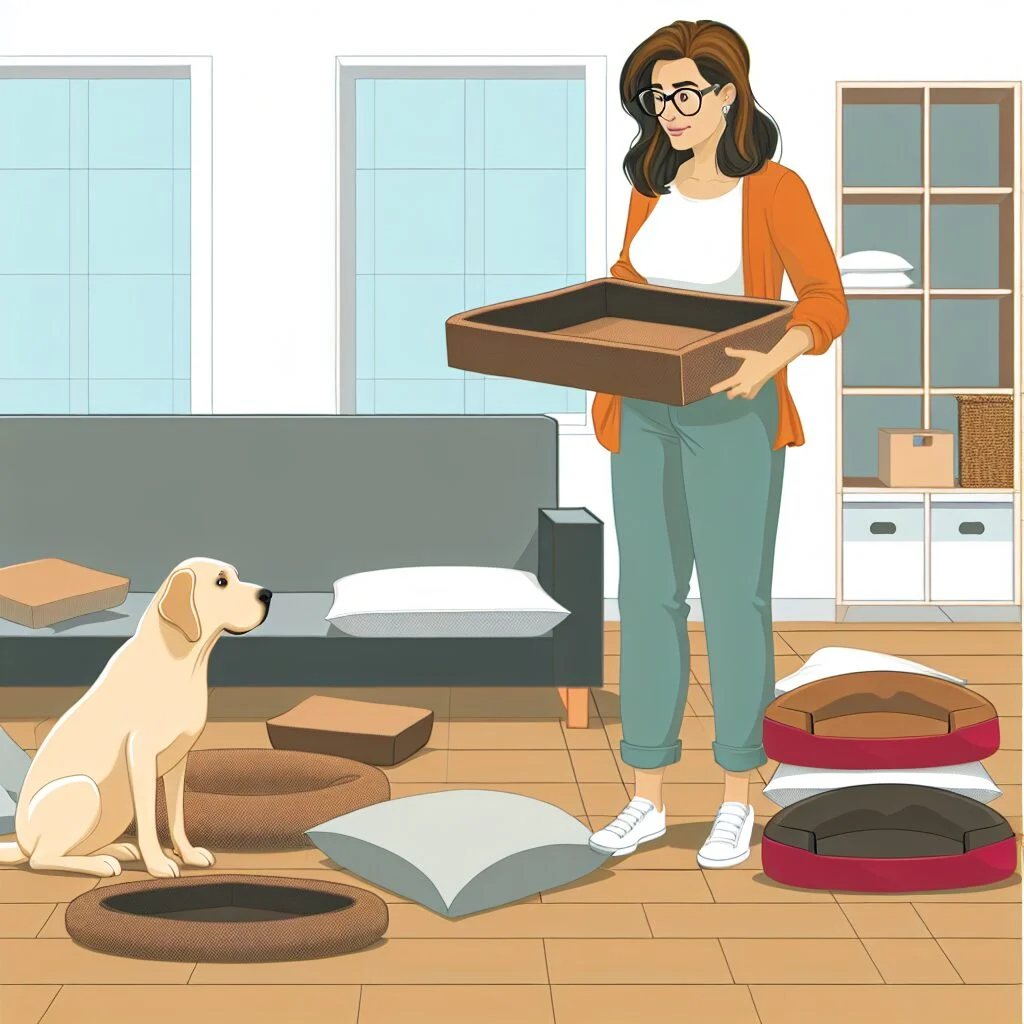Anxiety Beds for Humans: Finding Peaceful Sleep in a Restless World
In our fast-paced modern world, anxiety has become an unwelcome bedfellow for millions. The relationship between anxiety and sleep is particularly troublesome—a vicious cycle where anxious thoughts prevent rest, and sleep deprivation amplifies anxiety. If you find yourself staring at the ceiling night after night, mind racing with worries as the clock ticks forward, you’re not alone. An estimated 40 million adults in the United States suffer from anxiety disorders, and up to 70% of those with anxiety report sleep disturbances. This comprehensive guide explores how to transform your bed into a sanctuary for peace rather than a battlefield for anxious thoughts, offering evidence-based strategies, expert recommendations, and practical solutions for creating an anxiety-relieving sleep environment.
Understanding the Anxiety-Sleep Connection
Before diving into solutions, it’s crucial to understand why anxiety and sleep problems so often go hand-in-hand. When anxiety strikes, your body enters fight-or-flight mode, releasing stress hormones like cortisol and adrenaline. These hormones are designed to prepare your body for immediate action—not for peaceful slumber. Your heart rate increases, muscles tense, and your mind becomes hyperalert to potential threats. This physiological state is fundamentally incompatible with the relaxation necessary for sleep.
The relationship works in reverse too. Sleep deprivation reduces activity in the prefrontal cortex—the rational, logical part of your brain—while increasing activity in the amygdala, your brain’s fear center. This neurological shift makes you more reactive to stressors and less able to regulate emotional responses, creating perfect conditions for anxiety to flourish. Research from the University of California, Berkeley found that just one night of poor sleep can increase anxiety levels by up to 30%.
Anxiety is often about control,” notes clinical psychologist Dr. Sarah Henshaw. “When you’re lying in bed unable to fall asleep, that lack of control can amplify anxious thoughts.” The good news is that by understanding this connection, you can begin to implement strategies that address both sleep and anxiety simultaneously, breaking the cycle that keeps you awake and worried.
Creating an Anxiety-Reducing Sleep Environment
The Physical Components of an Anxiety Bed
Your sleep environment plays a crucial role in determining whether you’ll spend the night counting sheep or actually sleeping. Here’s how to transform your bedroom into an anxiety-reducing haven:
- Mattress selection: Look for mattresses that provide pressure relief and temperature regulation. Memory foam options like the Tempur-Pedic ProAdapt or hybrid mattresses like the Helix Midnight Luxe offer excellent support while reducing pressure points that can cause nighttime discomfort.
- Weighted blankets: These therapeutic blankets apply gentle, distributed pressure across your body, mimicking the sensation of being held or hugged. Research published in the Journal of Clinical Sleep Medicine found that weighted blankets can reduce anxiety and improve sleep quality. Aim for a blanket that’s approximately 10% of your body weight.
- Cooling bedding: Anxiety often causes your body temperature to rise, making sleep difficult. Cooling sheets made from bamboo or eucalyptus lyocell, like those from Sheets & Giggles or Buffy, can help regulate body temperature throughout the night.
- Blackout curtains: Light exposure, even minimal, can disrupt your body’s production of melatonin, the sleep hormone. Blackout curtains create the cave-like darkness that signals your brain it’s time to sleep.
- Sound machines: White noise or nature sounds can mask disruptive environmental noises while providing a consistent audio backdrop that soothes an anxious mind. The Yogasleep Dohm Classic or the Hatch Restore are excellent options backed by sleep specialists.
Optimizing Bedroom Atmosphere
Beyond the bed itself, the overall atmosphere of your bedroom impacts anxiety levels and sleep quality. Consider these environmental modifications:
- Temperature regulation: The ideal bedroom temperature for sleep is between 60-67°F (15-19°C). A programmable thermostat like the Nest or Ecobee can help maintain optimal temperatures throughout the night.
- Air quality: Poor air quality can exacerbate anxiety symptoms and disrupt sleep. HEPA air purifiers remove allergens and pollutants, creating cleaner air that promotes deeper sleep. The Levoit Core 300 and Coway AP-1512HH consistently receive top ratings from consumers and experts alike.
- Essential oil diffusers: Aromatherapy can significantly reduce anxiety symptoms. Lavender, chamomile, and bergamot have been scientifically proven to lower stress levels and improve sleep quality. The URPOWER 500ml or InnoGear diffusers are reliable options for bedroom use.
- Decluttering: A 2015 study published in the journal Sleep found that people who sleep in cluttered rooms are more likely to experience sleep disturbances. Implement storage solutions that keep your sleep space organized and visually calm.
- Electronic-free zones: The blue light emitted by phones, tablets, and computers suppresses melatonin production while their content can stimulate your mind rather than calm it. Create a charging station outside your bedroom and adopt an old-fashioned alarm clock instead of using your phone.
Anxiety-Calming Bedtime Routines
Creating an anxiety bed isn’t just about the physical components—it’s equally about establishing routines that signal to your nervous system that it’s safe to relax and sleep. “Human beings require structure,” emphasizes Dr. Henshaw. “By following a consistent bedtime routine, you’re able to take back some of anxiety’s power because you’re providing yourself extra stability and predictability.”
Creating a Sleep-Promoting Wind-Down Ritual
An effective bedtime routine begins 60-90 minutes before your target sleep time. This period serves as a buffer between daytime activities and sleep, allowing your mind and body to gradually transition. Consider incorporating these evidence-based practices:
- Consistent timing: “If you made a concerted effort to go to bed within a 20-minute window each night, get your 8 hours of sleep, and wake within the same 20-minute window each morning, you will gradually train your body and will make it much easier to get to sleep each night, especially when dealing with anxiety,” explains sleep specialist Dr. Michael Fish.
- Digital sunset: Implement a technology cutoff at least 60 minutes before bed. This reduces blue light exposure and mental stimulation that can interfere with melatonin production.
- Warm bath or shower: Research published in Sleep Medicine Reviews found that taking a warm bath 1-2 hours before bedtime can help you fall asleep an average of 10 minutes faster. The subsequent drop in body temperature after you exit the water mimics the natural temperature drop that occurs as your body prepares for sleep.
- Relaxation techniques: Progressive muscle relaxation, where you systematically tense and release muscle groups, has been shown to reduce anxiety and improve sleep quality. Similarly, deep breathing exercises that emphasize extended exhalation activate the parasympathetic nervous system, counteracting anxiety’s fight-or-flight response.
- Sleep-promoting beverages: Caffeine-free herbal teas containing chamomile, valerian root, or passionflower can promote relaxation. Avoid alcohol, which might help you fall asleep initially but disrupts sleep quality later in the night.
Journaling for Anxiety Management
One particularly effective bedtime ritual for anxiety sufferers is journaling. This practice offers multiple benefits: it provides an outlet for racing thoughts, creates a sense of control over worries, and helps identify anxiety patterns over time.
Consider these journaling approaches specifically designed for nighttime anxiety:
- Worry dump: Spend 15 minutes before bed writing down everything you’re worried about. Research from Baylor University found that writing a to-do list of future tasks helped people fall asleep faster than those who journaled about completed activities.
- Gratitude practice: Counterbalance anxiety’s negativity bias by recording three things you’re grateful for each night. A study in the Journal of Psychosomatic Research found that gratitude journaling improved both sleep quality and sleep duration.
- Thought challenging: When an anxious thought arises, write it down alongside evidence for and against it. This cognitive behavioral therapy technique helps identify cognitive distortions driving anxiety.
- Sleep journal: Track your sleep alongside daytime activities, allowing you to identify connections between specific behaviors and sleep quality.
Dr. Lauren Hahn, a mental health counselor specializing in anxiety and trauma therapy, notes that journaling can be particularly effective because it “creates a container for anxiety, giving your racing thoughts somewhere to go besides circling in your mind throughout the night.”
Mind-Body Techniques for Bedroom Anxiety Relief
Breathwork and Meditation
The breath provides a powerful tool for shifting from an anxious state to one conducive to sleep. These breathing techniques can be practiced in bed to calm a racing mind:
- 4-7-8 breathing: Developed by Dr. Andrew Weil, this technique involves inhaling for 4 counts, holding for 7 counts, and exhaling for 8 counts. This extended exhalation activates the parasympathetic nervous system, countering anxiety’s sympathetic arousal.
- Box breathing: Used by Navy SEALs to remain calm in high-stress situations, box breathing involves inhaling for 4 counts, holding for 4 counts, exhaling for 4 counts, and holding empty lungs for 4 counts. The precise counting occupies the mind while regulating the breath.
- Alternate nostril breathing: This yogic practice involves breathing through one nostril at a time, helping balance the nervous system and quiet mental chatter.
Meditation practices specifically designed for sleep can also transform your relationship with nighttime anxiety. Apps like Calm, Headspace, and Insight Timer offer guided sleep meditations that help direct attention away from anxious thoughts. Body scan meditations, which involve systematically bringing awareness to different parts of the body, are particularly effective for reducing physical tension associated with anxiety.
Physical Relaxation Techniques
Anxiety manifests physically as muscle tension, which can make falling asleep difficult. These techniques help release physical tension while in bed:
- Progressive muscle relaxation (PMR): Systematically tense and release muscle groups throughout your body, starting from your feet and working upward. Research published in the Journal of Behavioral Medicine found that PMR significantly improved sleep quality in people with insomnia.
- Gentle stretching: Simple bedtime yoga poses like child’s pose, legs-up-the-wall, and supine twists release physical tension accumulated throughout the day. Hold each pose for 2-3 minutes while breathing deeply.
- Acupressure: Applying gentle pressure to specific points can promote relaxation. The “Inner Gate” point, located three finger-widths above the wrist on the inner arm, has been shown to reduce anxiety when stimulated.
- Self-massage: Keep a tennis ball or massage tool by your bed for releasing tension in shoulders, neck, or feet—areas where anxiety often manifests physically.
Cognitive Strategies for Nighttime Anxiety
Restructuring Anxious Thoughts
Cognitive restructuring, a core component of cognitive behavioral therapy (CBT), involves identifying and challenging unhelpful thought patterns that fuel anxiety. When applied to bedtime anxiety, these techniques can be particularly effective:
- Thought stopping: When you notice yourself spiraling into anxious thoughts, mentally say “STOP” and redirect your attention to something more conducive to sleep, such as your breath or a peaceful visualization.
- Evidence examination: Ask yourself: “What evidence supports this worry?” and “What evidence contradicts it?” This rational approach can help defuse catastrophic thinking.
- Worst-case scenario analysis: If you find yourself catastrophizing, work through the worst-case scenario, identifying how you would cope if it occurred. This often reveals that even worst cases are manageable.
- Scheduled worry time: Set aside 15-20 minutes earlier in the day designated specifically for worrying. When anxious thoughts arise at bedtime, remind yourself that you can address them during tomorrow’s worry time.
Sleep-Promoting Visualizations
Visualization harnesses the mind’s power to create calming internal experiences, counteracting anxiety’s tendency to generate threatening scenarios. These visualizations are specifically designed to promote sleep:
- Descending staircase: Imagine slowly walking down a staircase, counting each step backward from 20 to 1. With each step, feel yourself becoming increasingly relaxed.
- Safe place visualization: Imagine a place—real or imagined—where you feel completely safe and peaceful. Engage all your senses in this visualization, noticing what you see, hear, smell, taste, and feel in this sanctuary.
- Body softening: Imagine each part of your body becoming increasingly heavy and soft, sinking comfortably into the mattress with each breath.
- Sleep stories: Create a gentle narrative to follow as you drift off, such as walking through a peaceful garden or floating down a calm river. The key is to make the story engaging enough to occupy your mind yet boring enough not to stimulate it.
Dr. Lauran Hahn notes that these visualizations work by “giving your mind something constructive to focus on rather than anxiety-provoking thoughts. They also engage the same neural pathways as actual experiences, allowing your body to respond with relaxation.”
Technology and Tools for Anxiety-Reducing Sleep
Apps and Digital Resources
While it’s generally recommended to avoid screens before bed, certain digital tools specifically designed to reduce anxiety and improve sleep can be exceptions to this rule:
- CBT-I apps: Cognitive Behavioral Therapy for Insomnia (CBT-I) is considered the gold standard for sleep improvement. Apps like Sleepio and CBT-i Coach provide digital versions of this evidence-based therapy.
- Sleep tracking: While obsessive sleep tracking can increase anxiety, mindful use of tools like Oura Ring or Withings Sleep Analyzer can help identify patterns and improvements over time.
- Guided meditation apps: Calm, Headspace, and Insight Timer offer specialized sleep meditations that guide you from wakefulness to sleep.
- ASMR content: Autonomous Sensory Meridian Response videos feature gentle sounds and visual triggers that many find deeply relaxing and sleep-inducing.
- Sleep podcasts: Programs like “Sleep With Me” or “Nothing Much Happens” provide bedtime stories specifically designed to be interesting enough to distract from anxious thoughts but boring enough to allow sleep.
Physical Tools and Gadgets
Beyond traditional bedding, innovative products designed specifically to address anxiety-related sleep problems have emerged in recent years:
- Smart beds: Adjustable beds like the Sleep Number 360 or the Eight Sleep Pod Pro allow customization of position, temperature, and firmness to create optimal sleeping conditions.
- Wearable sleep aids: Devices like the Apollo Neuro provide gentle vibrations that help regulate your nervous system, while the Muse S headband combines brain sensing technology with guided sleep journeys.
- Light therapy devices: Products like the Hatch Restore combine sound machine functionality with sunrise alarms that use gradually increasing light to wake you naturally, helping regulate your circadian rhythm.
- Cooling systems: The ChiliPAD or BedJet provide active temperature regulation throughout the night, maintaining the cool temperatures conducive to deep sleep.
- Sleep headphones: SleepPhones or Bose Sleepbuds offer comfortable ways to listen to meditation, white noise, or calming sounds without disturbing sleeping partners.
When selecting sleep technology, prioritize tools that don’t emit blue light or require significant screen time before bed. Set up automation when possible so these tools require minimal interaction at bedtime.
When to Seek Professional Help
Recognizing When DIY Methods Aren’t Enough
While the strategies outlined above can significantly improve sleep for many people with anxiety, it’s important to recognize when professional intervention is necessary. Consider seeking help if:
- You’ve consistently implemented good sleep hygiene and anxiety management techniques without improvement
- Sleep issues are significantly affecting your daytime functioning, relationships, or quality of life
- You experience panic attacks that wake you from sleep
- Your sleep problems are accompanied by depression symptoms or suicidal thoughts
- You find yourself using alcohol or other substances to manage sleep or anxiety
According to Lauran Hahn, mental health counselor specializing in anxiety and trauma therapy, there are specific treatments, like EMDR or sensorimotor psychotherapy, that can be helpful in “resetting” your nervous system and settling your overactive amygdala that’s causing your anxiety disorder. These specialized approaches may provide relief when self-help strategies fall short.
Professional Treatment Options
Several evidence-based treatments specifically address the anxiety-sleep connection:
- Cognitive Behavioral Therapy for Insomnia (CBT-I): This gold-standard treatment combines sleep restriction, stimulus control, cognitive restructuring, and sleep hygiene education. Studies show it’s more effective than sleep medication for long-term improvement.
- Acceptance and Commitment Therapy (ACT): Rather than trying to eliminate anxiety, ACT teaches you to accept it while still engaging in behaviors aligned with your values—like maintaining a consistent sleep schedule.
- Medication options: While not typically first-line treatments, medications like SSRIs can help manage underlying anxiety, while short-term use of sleep aids might be appropriate in some situations. Always discuss medication options with a healthcare provider.
- Specialized therapies: As Ms. Hahn mentioned, EMDR (Eye Movement Desensitization and Reprocessing) and sensorimotor psychotherapy can help address trauma underlying anxiety disorders that disrupt sleep.
When seeking professional help, consider a multidisciplinary approach. A therapist can provide psychological interventions, a psychiatrist can advise on medication options, and a sleep specialist can address specific sleep disorders that might be contributing to or resulting from anxiety.
Creating a Personalized Anxiety Bed Plan
Assessing Your Unique Needs
The ideal anxiety bed and sleep environment varies from person to person. What works for one anxiety sufferer might exacerbate problems for another. Consider these factors when developing your personalized approach:
- Anxiety triggers: Do you experience racing thoughts, physical tension, worry about not sleeping, or environmental sensitivities? Different triggers require different solutions.
- Sleep chronotype: Are you naturally a night owl or early bird? Working with rather than against your natural rhythm can reduce sleep-related anxiety.
- Sensory preferences: Do you find pressure calming or claustrophobic? Do you prefer silence or gentle background noise? Tailor your environment to your sensory needs.
- Cohabitation considerations: If you share your bed, compromise solutions like dual-firmness mattresses or separate blankets might be necessary.
Implementing and Adjusting Your Plan
Creating an anxiety-relieving sleep environment is not a one-time effort but an ongoing process of refinement:
- Start with fundamentals: Begin with basic sleep hygiene and gradually introduce additional elements rather than attempting a complete overhaul overnight.
- Track results: Keep a simple sleep journal noting changes made and their effects. This helps identify which interventions are most effective for you.
- Practice patience: Neurological patterns established over years take time to change. Expect gradual rather than immediate improvement.
- Seasonal adjustments: Your anxiety bed may need modifications throughout the year to account for changes in temperature, light, and seasonal anxiety patterns.
- Budget considerations: Prioritize investments based on your specific needs. Sometimes simple solutions like blackout curtains or a white noise app can make significant differences without major expense.
Remember that perfect sleep isn’t the goal—improvement is. Even reducing the time it takes to fall asleep by 15 minutes or decreasing nighttime awakenings can significantly impact your quality of life and daytime anxiety levels.
Conclusion: The Path to Peaceful Sleep
Creating an anxiety bed is about more than purchasing specific products or following rigid routines—it’s about developing a personalized approach to sleep that addresses your unique anxiety patterns. By combining environmental modifications, behavioral changes, cognitive strategies, and when necessary, professional support, you can transform your bed from an anxiety battleground to a sanctuary of peace.
Sleep and anxiety are intimately connected, each influencing the other in a continuous feedback loop. By intentionally intervening in this cycle, you create opportunities for both better sleep and reduced anxiety. Remember that improvements often come gradually, with each small step building toward significant long-term change.
As you implement the strategies discussed in this guide, approach the process with self-compassion rather than perfectionism. Some nights will be better than others, and that’s to be expected. The goal isn’t to eliminate anxiety entirely but to develop a relationship with it that doesn’t prevent the rest your mind and body need.
With patience, consistency, and the right customized approach, you can create an anxiety bed that supports not just better sleep but a more peaceful waking life as well. Sweet dreams are possible, even for the anxious mind.
FAQs About Anxiety Beds for Humans
What is an anxiety bed and how does it differ from a regular bed?
An anxiety bed isn’t a specific product but rather a sleep environment intentionally designed to reduce anxiety and promote better sleep. It typically incorporates elements like weighted blankets, cooling materials, supportive mattresses, and sensory tools specifically chosen to address anxiety symptoms. Unlike regular beds that focus primarily on comfort and support, anxiety beds also consider how each component affects the nervous system, stress levels, and anxiety triggers specific to the sleeper.
What bedding features are most helpful for people with nighttime anxiety?
The most helpful bedding features for nighttime anxiety include weighted blankets (10% of body weight) that provide gentle deep pressure stimulation; cooling fabrics like bamboo or eucalyptus that regulate temperature; breathable, moisture-wicking materials that prevent overheating; adjustable firmness mattresses that can be customized based on changing anxiety symptoms; and hypoallergenic materials that reduce potential irritants. Many anxiety sufferers also benefit from separate covers when sharing a bed, allowing for individual temperature and weight preferences without disturbing a partner.
How can I create a bedroom environment that reduces anxiety?
Create an anxiety-reducing bedroom by maintaining a cool temperature (60-67°F/15-19°C); using blackout curtains to eliminate light disruption; implementing a white noise machine or app to mask disruptive sounds; removing electronics and work-related items; using calming colors like soft blues, greens, or neutrals; incorporating essential oil diffusers with lavender or chamomile; minimizing clutter with proper storage solutions; and considering air purifiers to improve air quality. The ideal anxiety-reducing bedroom is a multi-sensory sanctuary that signals safety to your nervous system.
What bedtime routines help manage anxiety for better sleep?
Effective anxiety-reducing bedtime routines include: consistent sleep-wake times (within a 20-minute window); a technology cutoff 60-90 minutes before bed; relaxation practices like deep breathing or progressive muscle relaxation; warm baths or showers 1-2 hours before sleep; gentle stretching or bedtime yoga; journaling to externalize worries; reading physical books (rather than screens); drinking caffeine-free herbal teas like chamomile or valerian; and guided meditation specifically designed for sleep. The key is consistency—following the same routine nightly signals to your brain and body that it’s time to transition from wakefulness to sleep.
When should I seek professional help for nighttime anxiety?
Seek professional help when: sleep problems persist despite consistent good sleep hygiene practices; anxiety significantly impacts daytime functioning or relationships; you experience panic attacks that wake you from sleep; you rely on alcohol or substances to manage sleep; anxiety or insomnia is accompanied by depression symptoms; worry about sleep itself becomes a major source of distress; or you’ve tried multiple self-help strategies without improvement. Professionals can offer specialized treatments like Cognitive Behavioral Therapy for Insomnia (CBT-I), EMDR for trauma-related anxiety, or appropriate medication when necessary.
What technology or tools can help reduce anxiety in bed?
Helpful technology for reducing bed-related anxiety includes: weighted blankets (10% of body weight); sleep apps with guided meditation or sleep stories (Calm, Headspace); white noise machines or apps; cooling systems like ChiliPAD or BedJet; smart beds with adjustable firmness and temperature; sleep tracking devices used mindfully (Oura Ring, Withings Sleep Analyzer); sleep headphones designed for side-sleepers; light therapy devices for circadian rhythm regulation; and anxiety-specific wearables like Apollo Neuro that provide gentle vibrations to calm the nervous system. The most effective tools are those that require minimal interaction at bedtime and don’t emit blue light.
For additional resources on managing anxiety and improving sleep, visit Rise Science’s comprehensive guide on sleeping with anxiety or check out Harvard Medical School’s expert recommendations for anxiety-free sleep.



